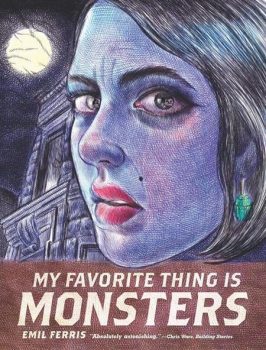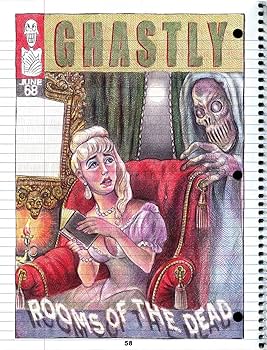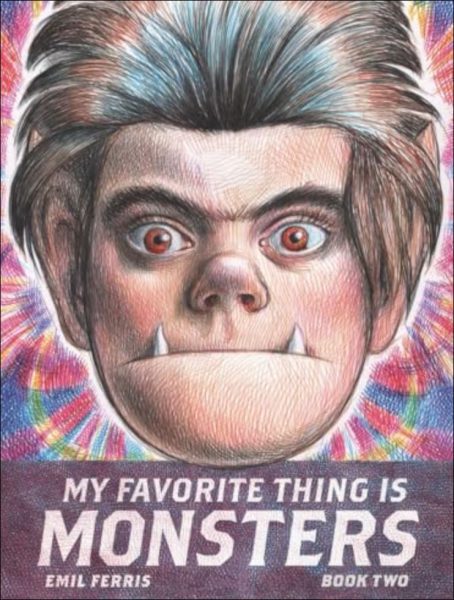“MY FAVORITE THING IS MONSTERS, BOOK TWO”:
SEQUEL TO THE GROUNDBREAKING GRAPHIC NOVEL BY EMIL FERRIS, ANOTHER MASTERPIECE OF GENRE EXPRESSION
by
Tom Lavagnino
Remember the kid sitting next to you in class who never paid any attention to the teacher — but who was drawing, drawing, drawing, incessantly, in his or her notebook? Remember how that same kid would “escape” by obsessively watching late-show horror movies on TV, embracing their power, imagery, and mystery, every weekend night?
Emil Ferris was that kid. Her epic, quasi-autobiographical graphic novel MY FAVORITE THING IS MONSTERS –- rendered entirely on “college-ruled notebook paper,” and boasting an artistic sensibility alternating between “realistic” portraits of Rembrandt-like detail and “expressionistic” Joe-Coleman-adjacent scenes of expressionistic horror –- became a publication sensation in 2017.

Now, seven years later, Ferris has produced a sequel. And like its antecedent, BOOK TWO is astonishing — a must-read masterpiece that re-defines the possibilities of the graphic novel, combining elements of classic E.C. comics with an intensely personal psychological bent that each and every ScareTube fan can relate to.
Book One focused its narrative on Karen Reyes, a 10-year-old girl growing up in a basement apartment in Chicago, whose identification with movie monsters is absolute (she sees herself, throughout the story, as a “wolf-girl” — complete with nascent Lon-Chaney-Jr.-esque fangs); her agenda was to solve the mystery of her upstairs neighbor Anka Silverman’s murder, a quest complicated by the riddles of Anka’s tortured past and Karen’s gradual suspicion that Deeze (Karen’s charismatic, twentysomething older brother, whom she idolizes to the heavens despite his secret illiteracy) was somehow, in some way or another, responsible for Anka’s killing.
Book Two continues this story as, in the wake of their mother’s death, Karen and Deeze — now parentless, and forced to share that basement apartment — struggle forward with their lives amidst the turbulent Chicago Summer of 1968. Karen continues chronicling her myriad adolescent incidents and tensions in the volatile notebook, meeting fellow artist (and horror-lover) Shelley at school; they form an instant emotional and monster-based bond, with a mantra of EGOTBU –- Eternal Guild Of The Benevolent Undead. After discovering old cassette tapes in Anka’s deserted apartment, Karen brings Shelley up to speed on Anka’s horrific, first-person-narrated past as a concentration-camp survivor (revelations reminiscent of Art Spiegelman’s Pulitzer-Prize-winning graphic novel MAUS) — which serve to catapult Karen and Shelley into even more mysterious (and dangerous) realms of personal investigation. Karen’s brother Deeze meanwhile dodges the military (they’re trying to enlist him to go to Viet Nam) while attempting to market his own highly-accomplished artwork. But the ruse doesn’t quite track with Karen (“Deeze throws away drawings when he doesn’t like them. It is my opinion that the reason he tosses certain drawings is because those drawings — the artworks he hates — are the truest clues to what is going on in Deeze’s head”); she observes her brother falling deeper and deeper into desperation -– and criminality. How these two siblings navigate their fraught, emotionally-piquant relationship –- articulated, as in Book One, with weekly trips to the Art Institute of Chicago and strolls down Michigan Avenue (Deeze knowledgeably pointing out the many “hidden” artistic flourishes in all the paintings and frescoes) — forms the emotional bedrock of Ferris’ ever-compelling story.
While the Pixar INSIDE OUT movies couldn’t be further afield in tone (and ScareTube demographic!) from Ferris’ creation, she communicates Karen’s moment-by-moment emotional tenor with similarly clarity-based intensity. The character’s distinct POV, while defiantly singular, is nevertheless irresistible; the stylized visual representation of Karen’s moment-to-moment emotional state, conveyed through imagined “horror comic cover pages” (“GHASTLY,” “ARCANE,” “SINISTER,” and “SPECTRAL” among them), perfectly encapsulates the vulnerability of grammar school, the difficulty in forging an artistic life, and the budding sexuality accompanying it all.
“For a second,” Karen muses, “I was almost sure that death is just the experience of being hugged by the unknown.” Indeed, one of the supreme accomplishments of MY FAVORITE THING IS MONSTERS, BOOK TWO is the means by which fear and horror are articulated, through Karen’s unique world-view, as routine, mundane, and unremarkable — a bedrock of human existence. And while a “graphic novel” explication of the idea would appear, on the face of it, to be somewhat distancing for a reader, in Ferris’ remarkable hands it’s instead utterly galvanizing.
“Pretend to be defeated in order to survive,” insists Anka, tragically, on her cassette tapes. My advice? Don’t pretend that MY FAVORITE THING IS MONSTERS, BOOK TWO is anything other than the horror publishing event of the year.
Tom Lavagnino is a playwright, television producer and golfer (18 handicap) living in Southern California. www.tomlavagnino.com







